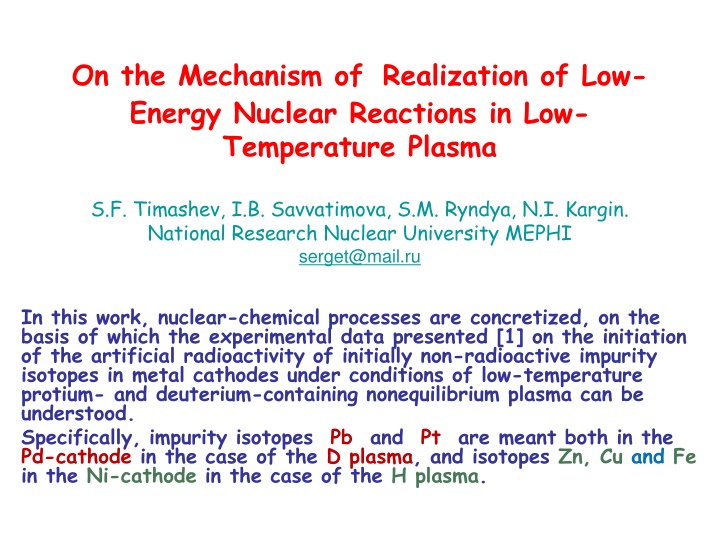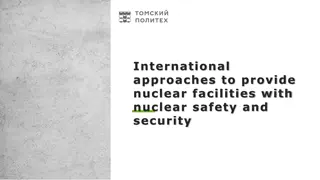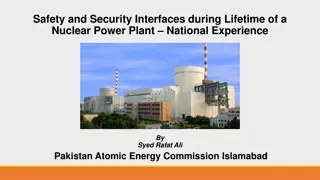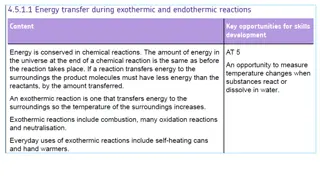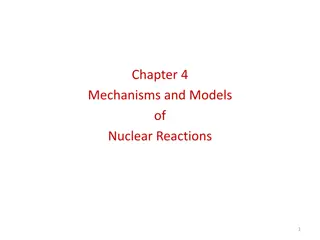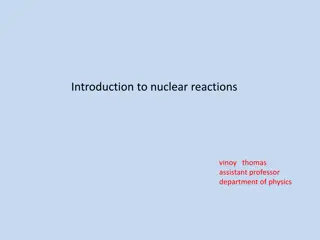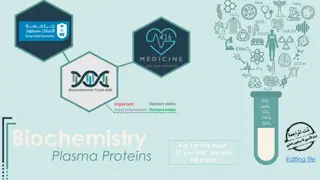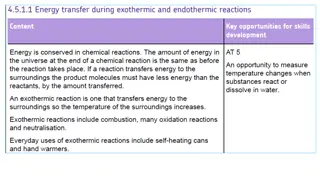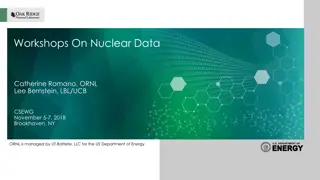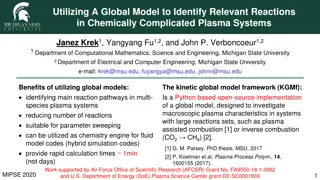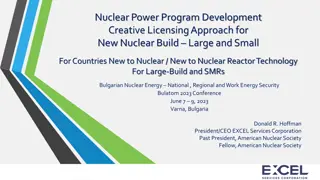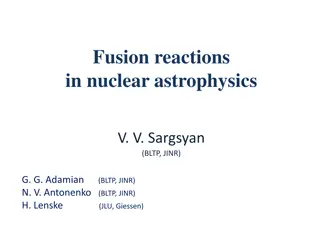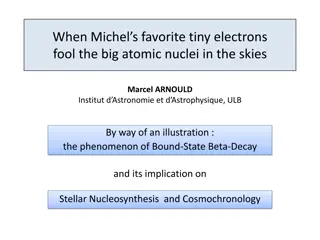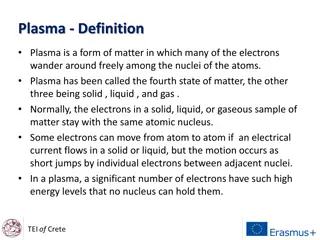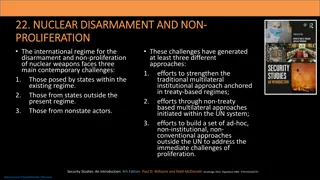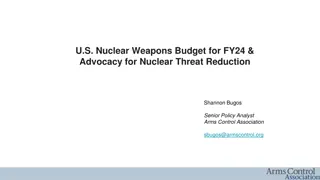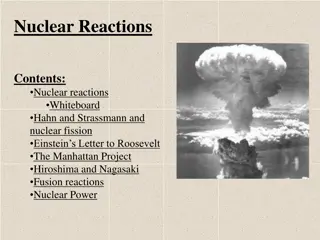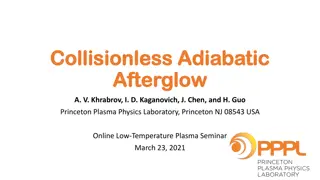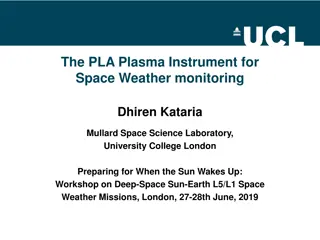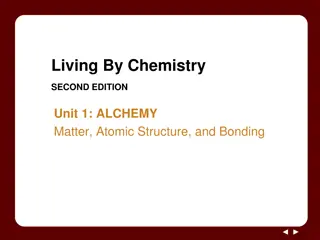Mechanism of Low-Energy Nuclear Reactions in Low-Temperature Plasma
This work discusses nuclear-chemical processes underlying low-energy nuclear reactions in low-temperature plasma environments, focusing on the initiation of artificial radioactivity in metal cathodes under protium- and deuterium-containing nonequilibrium plasma conditions. The role of electrons with sufficient kinetic energy in inducing nuclear transformations is highlighted, leading to the formation of anomalous nuclei that participate in nuclear reactions. The involvement of -neutrons and -dineutrons in nuclear processes is explained, particularly their potential impact on compound nuclei formation in the absence of Coulomb barriers.
Download Presentation

Please find below an Image/Link to download the presentation.
The content on the website is provided AS IS for your information and personal use only. It may not be sold, licensed, or shared on other websites without obtaining consent from the author.If you encounter any issues during the download, it is possible that the publisher has removed the file from their server.
You are allowed to download the files provided on this website for personal or commercial use, subject to the condition that they are used lawfully. All files are the property of their respective owners.
The content on the website is provided AS IS for your information and personal use only. It may not be sold, licensed, or shared on other websites without obtaining consent from the author.
E N D
Presentation Transcript
On the Mechanism of Realization of Low- Energy Nuclear Reactions in Low- Temperature Plasma S.F. Timashev, I.B. Savvatimova, S.M. Ryndya, N.I. Kargin. National Research Nuclear University MEPHI serget@mail.ru In this work, nuclear-chemical processes are concretized, on the basis of which the experimental data presented [1] on the initiation of the artificial radioactivity of initially non-radioactive impurity isotopes in metal cathodes under conditions of low-temperature protium- and deuterium-containing nonequilibrium plasma can be understood. Specifically, impurity isotopes Pb and Pt are meant both in the Pd-cathode in the case of the D plasma, and isotopes Zn, Cu and Fe in the Ni-cathode in the case of the H plasma.
Earlier it was shown [2-5] that a wide variety of low-energy nuclear transformations studied under conditions of a nonequilibrium low- temperature glow discharge plasma and laser ablation of metals in aqueous media can be understood on the basis of the concepts of the dynamic interrelation between the electron and nuclear subsystems of an atom. The initiating role in such processes belongs to electrons a sufficiently large kinetic energy Ee ~ 3-5 eV (by chemical scales), which they can acquire under the indicated conditions. Inelastic scattering of electrons by nuclei in according to weak nuclear interaction becomes possible in the collision of such electrons with ions or plasma atoms (here we assume that the nuclei are not related to K-capture nuclei). At the first stage of such a nuclear-chemical interaction, a nucleus arises, the charge of which is one unit less than the charge of the initial nucleus, and nuclear matter is locally disrupted: the nuclear mass in this case is insufficient to preserve nuclear matter in the base state of interacting nucleons. Under such anomalous excitations of nuclear matter, which are characterized as the states of inner shake-up or isu-state, the relaxation dynamics of the nuclei is initiated by weak nuclear interactions. Such nuclei, being -active ( -nuclei ), can have sufficiently long lifetimes and effectively participate in nuclear reactions (as the -neutron and -dineutron consideration). introduced into
The simplest -nuclei are the -neutron and -dineutron, which can be formed by the interaction of high-energy electrons with protons or deuterons, for example, by laser ablation of metals in ordinary or heavy water, and also under conditions of protius-containing or deuteron- containing glow discharge plasma, respectively, according to , . (1) (2) If the half-lives of such -nuclei are sufficiently long, the neutral nuclei and , respectively, with baryon numbers equal to one and two, zero lepton charges and rest masses equal to the masses of the hydrogen atom and deuterium, can effectively participate in a variety of nuclear processes [2-4]. It was shown earlier that the half-life of the -dineutron: (3) with the formation of a deuteron, an electron, and an antineutrino, turns out to be sufficiently long, at least tens of minutes. This conclusion is based on an analysis of the experimental data on the synthesis of tritium nuclei t+ upon the laser ablation of metals in heavy water [5].
In the absence of Coulomb barriers, these nuclei effectively participate in nuclear chemical processes, forming compound nuclei with target nuclei, in which the nucleonic structure is also disturbed. The latter factor determines the relaxation of the excitations of compound nuclei during their decay (with the formation of products) not by the emission of -quanta, as it is realized in in the case of a well-defined nucleonic structure of excited nuclei, but by the URCA process by the emission of neutrino-antineutrino pairs that are safe for the environment. The literature data (A. Klimov et al. [6]) are presented, independently indicating the possibility of existence in the discharge chamber of the plasma vortex reactor (testing gas flow- water steam) of neutron-like nuclei, which may turn out to be the particles whose mass is 0.78 MeV less than the mass of a neutron. Indeed, according to [6], neutron-like nuclei are recorded as neutrons on proportional He-3 detectors, but the test reaction for neutrons of initiation of artificial radioactivity of indium by streams of these particles gives a negative result. These results give reason to believe that in many works that reported the production of neutrons under sufficiently low-energy influences, from the point of view of nuclear physics (see, for example, [7-12]), in fact, neutral particles or considered in this communication were generated. In this case, -dineutrons formed in deuteron- containing media, when using neutron detectors, could initiate processes in which a neutron is absorbed and a neutral particle is emitted, perceived as a neutron, although the mass of this particle is 0.78 MeV/ less than the neutron mass.
Below we present several examples of processes, indicated in [1], that result in a decrease in the content of isotopes of impurity elements (Pb-206 and Pt-196) in the Pd-cathode when exposed to streams of deuterium-containing plasma, and thus isotopes W-186 are formed: (4) (5) as well as impurity elements Zn-64, Cu-65 and Fe-56 in Ni-cathode for which the content of isotopes decreases when exposed to flows of protium-containing plasma): (6) (7) (8) It should be emphasized that it was precisely the introduction of the concept of the existence in nuclear matter of non-nucleon metastable excitations initiated by electrons of high (in terms of chemical scales) energies and sufficiently long-lived, which determines the existence of light neutral nuclei, -neutron and -dineutron, that made it possible to understand the reasons for the high efficiency of the effects to cathodes of plasma flows, the characteristic energy density of which is 5-6 orders of magnitude lower than those usually used for these purposes in nuclear physics, as well as the safety of the manifestation of these particles in nuclear processes.
REFERENCES [1] Savvatimova I.B., Poteshin S.S., Kargin N.I., Sysoev A.A., RyndyaS.M., Timashev S.F.ICP mass spectrometry in the analysis of the phenomenon of low-energy nuclear reactions initiated in metals under the conditions of a glow discharge . This Conference. [2] Timashev Serge. On mechanisms of low-energy nuclear-chemical processes , RENSIT, vol. 9, no. 1, pp. 37-51, 2017; http://en.rensit.ru/vypuski/article/200/9(1)37-51e.pdf [3] Timashev Serge. Metastable Non-Nucleonic States of Nuclear Matter: Phenomenology , Physical Science International Journal, vol. 15, no. 2, pp. 1-25, 2017; http://www.sciencedomain.org/issue/2727 [4] Timashev S.F. Physical vacuum as a system manifesting itself on various scales - from nuclear physics to cosmology / arXiv:1107.1799v8 [pdf] [5]Barmina E.V., Timashev S.F., Shafeev G.A. Laser-induced synthesis and decay of Tritium under exposure of solid targets in heavy water // Journal of Physics: Conference Series. 2016. V. 688. 012106. (8th International Conference on Inertial Fusion Sciences and Applications (IFSA 2013) IOP Publishing; / http://arxiv.org/abs/1306.0830[physics.gen-ph] [6] Klimov A.I., Belov N.K., Tolkunov B.N. Neutron flux and soft X-radiation created by heterogeneous plasmoid , J. of Physics: Conference Series, 19th Int. Workshop MPA, vol. 1698, p. 012034, 2020. [7] Artsimovich L A "Research on controlled thermonuclear reactions in the U.S.S.R." Sov. Phys. Usp. 1 191 207 (1958) [8] Basov N.G., Zakharov S.D., rjukov Yu.V. et al. Experiments on the observation of neutrons by focusing high-power laser radiation on the surface of lithium deuteride // JETP Letters. 1968. V. 8. P. 26 (in Russian). [9] Derjagin B.V., Klyuev V.A., Lipson A.G., ToporovYu.P. Possibility of nuclear reactions during the fracture of solids // Colloid Journal USSR. 1986. V. 48 (1). P. 8-10.); [10] Schenkel T., Persaud A., Wang H. et al. Investigation of light ion fusion reactions with plasma discharges // J. Appl. Phys. 126, 203302 (2019); doi: 10.1063/1.5109445 [11]Golishnikov D.M., Gordienko V.M., Eremin N.V. et al. Khomenko A.S., Rakov E.V., Savel ev A.B., Volkov R.V. Laser-Induced Deuteration of a Titanium Target and Neutron Generation under the Action of Superintense Femtosecond Laser Radiation // Laser Physics, Vol. 15, No. 8, 2005, pp. 1154 1162. [12]Smith P.J., Hendricks R.C., Steinetz B.M. Electrolytic co-deposition neutron production measured by bubble detectors// Journal of Electroanalytical Chemistry. 2021. V. 882, 1 February 2021, 115024.
